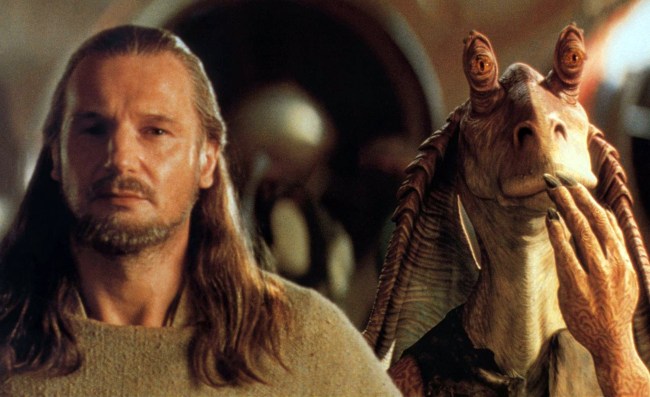The second season of “Light & Magic,” about the history of VFX giant Industrial Light & Magic (helmed by “Jumanji” director and former ILM vet Joe Johnston), kicks off with a fascinating glimpse into the making of Jar Jar Binks in the first of three episodes.
The initial fan response to the character was decidedly negative, whether for Jar Jar’s slapstick humor tone clashing with the other stories within “Star Wars: Episode I — The Phantom Menace” or for the Gungan’s broad characterization that some critics and audiences found reflected racist stereotypes. Jar Jar hate has softened a little over time, particularly concerning the work of performer Ahmed Best, who beat out both Robin Williams and Michael Jackson for the role of Binks and has now gotten to save Baby Yoda in the guise of Jedi Master Kelleran Beq in “The Mandalorian.” But Best was the first to step into a mocap suit, and Jar Jar marked the industry’s first major mocap/CG character.
That’s right: Jar Jar helped pave the way for Andy Serkis’ Gollum and Caesar and every other innovative CG character that has been mo-capped, performance-captured, or keyframed in the 21st century.
Conceived by George Lucas as the synthetic centerpiece of “The Phantom Menace,” Jar Jar was modeled after the physical genius of Buster Keaton (“The General”) and intended for comic relief. Indeed, Best was cast for the malleable mannerisms and babbling delivery displayed in his stand-up comedy, and sat with Lucas to study the motivation behind Keaton’s movement.
While ILM had previously introduced groundbreaking CG characters, such as the dinosaurs in “Jurassic Park,” (1993), the titular ghost in “Casper,” (1995), and Sean Connery’s distinguished Draco in “Dragonheart,” (1996), Jar Jar was their first CG humanoid, who had to perform believably alongside Liam Neeson’s Qui-Gon Jinn and the other actors.
“I know it’s gonna work because…it’s impossible,” Lucas said in archival footage of a staff meeting. One of the early challenges, though, was Jar Jar needed to be designed from scratch by then-newbie designer Doug Chiang (“The Mandalorian”) and the rest of the art department. But it was concept artist Terryl Whitlatch who came up with the first amphibious sketch that excited Lucas. From there, they played with an alligator, frog, salamander, elephant, pig, and dachshund. In the end, Jar Jar was a combination of a dinosaur and an amphibian with a parrotfish pattern on his skin. For Lucas, though, it was especially important that his eyes popped out and that he had floppy ears.
The hardest task was animating Jar Jar during the dawn of mocap and computer graphics. This fell to animation supervisor Rob Coleman and VFX supervisor John Knoll. At first, for budgetary reasons, it was decided that Best was going to wear a prosthetic suit, and ILM was only going to animate his head. The suit would also be worn on set by Best (with Jar Jar’s head as a hat) during interaction with the other actors.
But Knoll wanted Jar Jar to be all-CG. He was convinced that ILM could pull it off and that it would be the best solution in the long run. That’s because of the hassle involved in getting the correct alignment to blend all of the elements and then having to match the lighting on set.
So they arranged a side-by-side animation test comparing the head replacement with the full-CG version. “It was incredibly difficult, it was really, really hard,” Coleman told Johnston. “Even if we got the neck in, even if it was a pixel off, our eye sees it as a misalign and didn’t believe in it. And the side-by-side is what we showed to George, and made our case about why this is going to be really hard to pull off, just to do the neck and head.”
However, visual effects supervisor Dennis Muren (“Jurassic Park”) was skeptical that replacing the head and neck would actually be more expensive than doing Jar Jar full CG. “The rumor I heard later was that it was not true,” Muren told Johnston. “They actually gave the matchmove of the head to an animator who was not very fast, and they gave the full animation version to an animator who was super fast.” Asked by Johnston if he believed the rumor, Muren responded: “It’s true. George told me about it, and I said, ‘That makes sense.’”
While Lucas was impressed with the full CG test, he was concerned that it would detract from Best’s performance. But doing it with the experimental mocap made it possible to keep the essence of Best’s wiry performance as Jar Jar. They could capture all of his movement without having to animate it and carry it into different scenes. Then the animators could take over and finish the rest with their skillful photorealism.
“There were times that I thought that…maybe we were making the character too slapstick or too goofy,” added Coleman. “But, at every turn, George said, ‘No, no, no. This is his role within the movie, this is his position within the story.’ I told him once, ‘I don’t want this to be Goofy.’ And he said, ‘Dare to be Dopey, Rob. Make this Dopey.’ I’m like, ‘OK,’ and so we did.”
“Light & Magic” Season 2 currently streams on Disney+.



